名词,冠词用法
- 格式:docx
- 大小:18.49 KB
- 文档页数:6
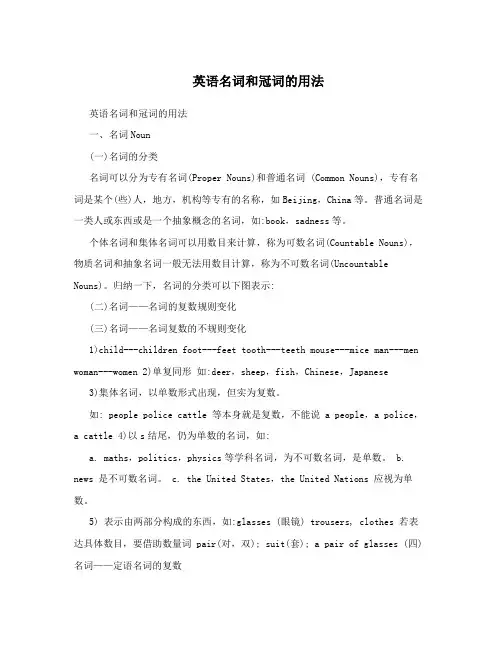
英语名词和冠词的用法英语名词和冠词的用法一、名词Noun(一)名词的分类名词可以分为专有名词(Proper Nouns)和普通名词 (Common Nouns),专有名词是某个(些)人,地方,机构等专有的名称,如Beijing,China等。
普通名词是一类人或东西或是一个抽象概念的名词,如:book,sadness等。
个体名词和集体名词可以用数目来计算,称为可数名词(Countable Nouns),物质名词和抽象名词一般无法用数目计算,称为不可数名词(Uncountable Nouns)。
归纳一下,名词的分类可以下图表示:(二)名词——名词的复数规则变化(三)名词——名词复数的不规则变化1)child---children foot---feet tooth---teeth mouse---mice man---men woman---women 2)单复同形如:deer,sheep,fish,Chinese,Japanese3)集体名词,以单数形式出现,但实为复数。
如: people police cattle 等本身就是复数,不能说 a people,a police,a cattle 4)以s结尾,仍为单数的名词,如:a. maths,politics,physics等学科名词,为不可数名词,是单数。
b. news 是不可数名词。
c. the United States,the United Nations 应视为单数。
5) 表示由两部分构成的东西,如:glasses (眼镜) trousers, clothes 若表达具体数目,要借助数量词 pair(对,双); suit(套); a pair of glasses (四)名词——定语名词的复数名词作定语一般用单数,但也有以下例外。
1) 用复数作定语。
如:sports meeting 运动会2) man, woman, gentleman等作定语时,其单复数以所修饰的名词的单复数而定。
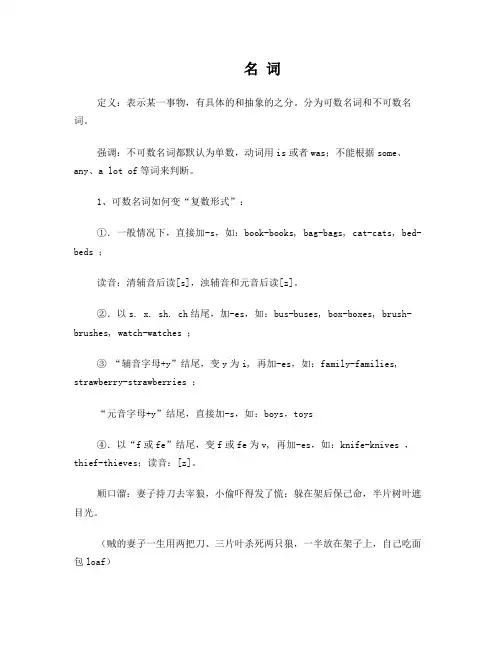
名词定义:表示某一事物,有具体的和抽象的之分。
分为可数名词和不可数名词。
强调:不可数名词都默认为单数,动词用is或者was;不能根据some、any、a lot of等词来判断。
1、可数名词如何变“复数形式”:①.一般情况下,直接加-s,如:book-books, bag-bags, cat-cats, bed-beds ;读音:清辅音后读[s],浊辅音和元音后读[z]。
②.以s. x. sh. ch结尾,加-es,如:bus-buses, box-boxes, brush-brushes, watch-watches ;③ “辅音字母+y”结尾,变y为i, 再加-es,如:family-families, strawberry-strawberries ;“元音字母+y”结尾,直接加-s,如:boys,toys④.以“f或fe”结尾,变f或fe为v, 再加-es,如:knife-knives ,thief-thieves;读音:[z]。
顺口溜:妻子持刀去宰狼,小偷吓得发了慌;躲在架后保己命,半片树叶遮目光。
(贼的妻子一生用两把刀、三片叶杀死两只狼,一半放在架子上,自己吃面包loaf)wife(妻子),knife(刀子),wolf(狼)thief(小偷),shelf(架子),self(自己),life(生命)half(一半),leaf(树叶)。
这9个名词变复数时,都要改“f(e)”为“ve”再加“s”。
特殊情况是直接加-s的:顺口溜:海湾边、屋顶上,首领农仆相望;谁说他们无信仰,语气定在手帕上。
gulf, roof, chief, serf, belief, proof, handkerchief。
这些词是直接加-s的。
⑤.以“o”结尾的词,分两种情况:1)有生命的+es 读音:[z] 如:mango-mangoes,tomato-tomatoes,hero-heroes,negro—negroes (袋鼠除外cangro-cangros)顺口溜:两人两菜一火山(黑人英雄在火山上吃土豆,西红柿,芒果和河马)2)无生命的+s 读音:[z] 如:zoo-zoos, radio-radios, photo-photos, piano-pianos,(袋鼠除外cangro-cangros)zero-zeros, bamboo(竹竿)-bamboos, tobacco(烟丝)-tobaccos顺口溜:动物园里挂着一张照片,照片上是一片竹林前的钢琴上放着一台收音机⑥. 部分单词的单复数同形顺口溜:中日警察来聚会,鹿、羊、鱼、牛把家回。
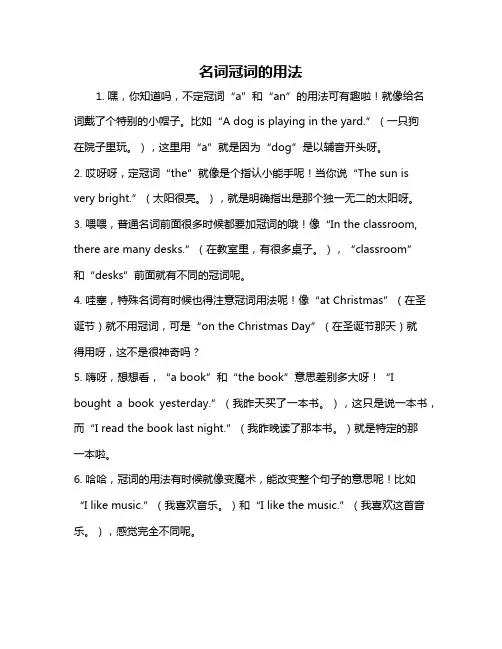
名词冠词的用法1. 嘿,你知道吗,不定冠词“a”和“an”的用法可有趣啦!就像给名词戴了个特别的小帽子。
比如“A dog is playing in the yard.”(一只狗在院子里玩。
),这里用“a”就是因为“dog”是以辅音开头呀。
2. 哎呀呀,定冠词“the”就像是个指认小能手呢!当你说“The sun is very bright.”(太阳很亮。
),就是明确指出是那个独一无二的太阳呀。
3. 喂喂,普通名词前面很多时候都要加冠词的哦!像“In the classroom, there are many desks.”(在教室里,有很多桌子。
),“classroom”和“desks”前面就有不同的冠词呢。
4. 哇塞,特殊名词有时候也得注意冠词用法呢!像“at Christmas”(在圣诞节)就不用冠词,可是“on the Christmas Day”(在圣诞节那天)就得用呀,这不是很神奇吗?5. 嗨呀,想想看,“a book”和“the book”意思差别多大呀!“I bought a book yesterday.”(我昨天买了一本书。
),这只是说一本书,而“I read the book last night.”(我昨晚读了那本书。
)就是特定的那一本啦。
6. 哈哈,冠词的用法有时候就像变魔术,能改变整个句子的意思呢!比如“I like music.”(我喜欢音乐。
)和“I like the music.”(我喜欢这首音乐。
),感觉完全不同呢。
7. 哟呵,名词和冠词搭配起来可真有讲究!“a beautiful girl”(一个漂亮女孩),要是没了“a”,那可就不对劲啦。
8. 嘿嘿,学会了冠词和名词的用法,是不是感觉英语更有趣了?以后说话写句子就可以更准确啦!我的观点就是:冠词和名词的用法虽然有点复杂,但是真的很重要呀,掌握了它们,英语就能说得更地道啦!。
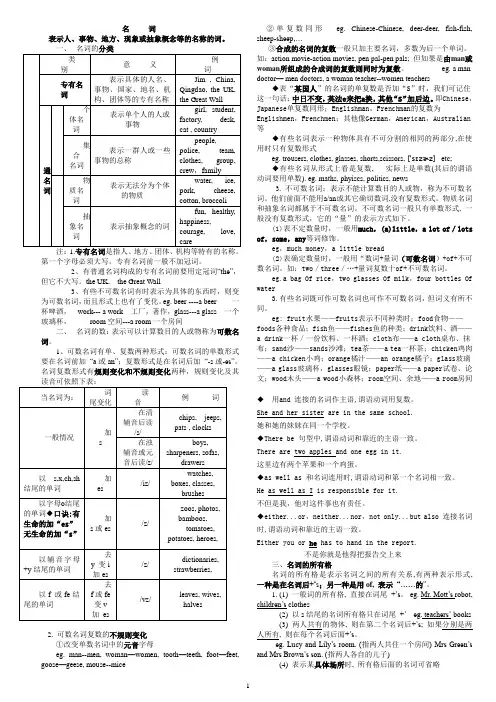
名 词 表示人、事物、地方、现象或抽象概念等的名称的词。
第一个字母必须大写。
专有名词前一般不加冠词。
2、有普通名词构成的专有名词前要用定冠词“the”,但它不大写。
the UK, the Great Wall3、有些不可数名词有时表示为具体的东西时,则变为可数名词,而且形式上也有了变化。
eg. beer ----a beer 一杯啤酒, work--- a work 工厂,著作,glass---a glass 一个玻璃杯, room 空间---a room 一个房间二、 名词的数:表示可以计算数目的人或物称为可数名词。
1、可数名词有单、复数两种形式:可数名词的单数形式要在名词前加 “a 或a n”;复数形式是在名词后加 “-s 或-es”。
名词复数形式有规则变化和不规则变化两种,规则变化及其2. 可数名词复数的不规则变化①改变单数名词中的元音字母eg. man--men, woman —women, tooth —teeth, foot —feet,goose —geese, mouse--mice ②单复数同形 eg. Chinese-Chinese, deer-deer, fish-fish,sheep-sheep,… ③合成的名词的复数一般只加主要名词,多数为后一个单词。
如:action movie-action movies, pen pal-pen pals; 但如果是由man 或woman 所组成的合成词的复数则同时为复数。
eg. a man doctor — men doctors, a woman teacher--women teachers ◆表“某国人”的名词的单复数是否加“S ”时,我们可记住这一句话:中日不变,英法e 来把a 换,其他“S ”加后边。
即Chinese ,Japanese 单复数同形;Englishman ,Frenchman 的复数为Englishmen ,Frenchmen ;其他像German ,American ,Australian等 ◆有些名词表示一种物体具有不可分割的相同的两部分,在使用时只有复数形式 eg. trousers, clothes, glasses, shorts,scissors, ['s ɪz ɚz] etc; ◆有些名词从形式上看是复数, 实际上是单数(其后的谓语动词要用单数). eg. maths, phyiscs, politics, news 3. 不可数名词:表示不能计算数目的人或物,称为不可数名词。
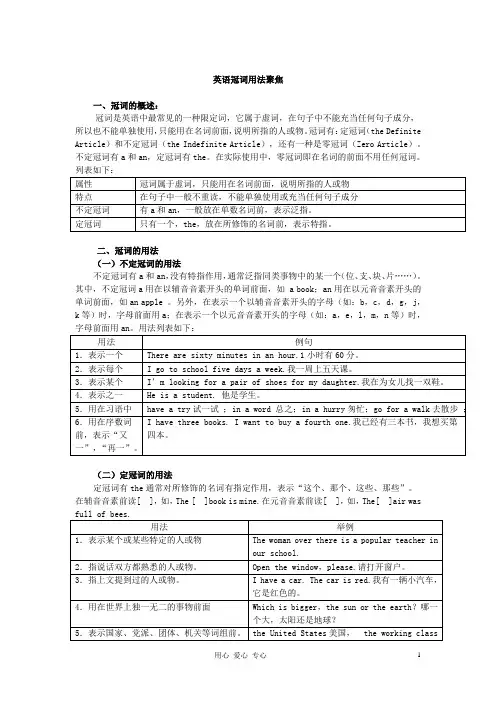
英语冠词用法聚焦一、冠词的概述:冠词是英语中最常见的一种限定词,它属于虚词,在句子中不能充当任何句子成分,所以也不能单独使用,只能用在名词前面,说明所指的人或物。
冠词有:定冠词(the Definite Article)和不定冠词(the Indefinite Article),还有一种是零冠词(Zero Article)。
不定冠词有a和an,定冠词有the。
在实际使用中,零冠词即在名词的前面不用任何冠词。
列表如下:二、冠词的用法(一)不定冠词的用法不定冠词有a和an,没有特指作用,通常泛指同类事物中的某一个(位、支、块、片……)。
其中,不定冠词a用在以辅音音素开头的单词前面,如 a book;an用在以元音音素开头的单词前面,如an apple 。
另外,在表示一个以辅音音素开头的字母(如:b,c,d,g,j,k等)时,字母前面用a;在表示一个以元音音素开头的字母(如:a,e,l,m,n等)时,(二)定冠词的用法定冠词有the通常对所修饰的名词有指定作用,表示“这个、那个、这些、那些”。
在辅音音素前读[ ],如,The [ ]book is mine.在元音音素前读[ ],如,The[ ]air was(三)零冠词的用法(四)用与不用不定冠词的差异1.英语中的某些名词既可用作不可数名词又可用作可数名词,但含义不同,用法也不一样。
例如:glass玻璃 a glass 一个玻璃杯 Light travels faster than sound.光速比声速快。
Be quiet. Don’t let me hear a sound.请安静,不要让我听到动静。
另有一些不可数名词如果有形容词作定语,一般要用a 于前面:a heavy rain一场大雨2.“with+抽象名词=副词”时,抽象名词前不用不定冠词。
如:with pleasure乐意地;with anger 生气地但在“with + a +名词”这种结构中,虽用不定冠词,却没有实际意义。
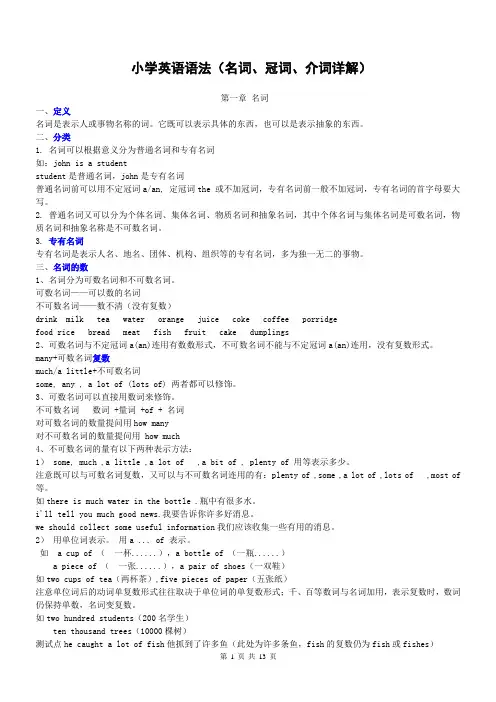
小学英语语法(名词、冠词、介词详解)第一章名词一、定义名词是表示人或事物名称的词。
它既可以表示具体的东西,也可以是表示抽象的东西。
二、分类1. 名词可以根据意义分为普通名词和专有名词如:john is a studentstudent是普通名词,john是专有名词普通名词前可以用不定冠词a/an, 定冠词the 或不加冠词,专有名词前一般不加冠词,专有名词的首字母要大写。
2. 普通名词又可以分为个体名词、集体名词、物质名词和抽象名词,其中个体名词与集体名词是可数名词,物质名词和抽象名称是不可数名词。
3.专有名词专有名词是表示人名、地名、团体、机构、组织等的专有名词,多为独一无二的事物。
三、名词的数1、名词分为可数名词和不可数名词。
可数名词——可以数的名词不可数名词——数不清(没有复数)drink milk tea water orange juice coke coffee porridgefood rice bread meat fish fruit cake dumplings2、可数名词与不定冠词a(an)连用有数数形式,不可数名词不能与不定冠词a(an)连用,没有复数形式。
many+可数名词复数much/a little+不可数名词some, any , a lot of (lots of) 两者都可以修饰。
3、可数名词可以直接用数词来修饰。
不可数名词数词 +量词 +of + 名词对可数名词的数量提问用how many对不可数名词的数量提问用 how much4、不可数名词的量有以下两种表示方法:1) some, much ,a little ,a lot of ,a bit of , plenty of 用等表示多少。
注意既可以与可数名词复数,又可以与不可数名词连用的有:plenty of ,some ,a lot of ,lots of ,most of 等。
如there is much water in the bottle .瓶中有很多水。
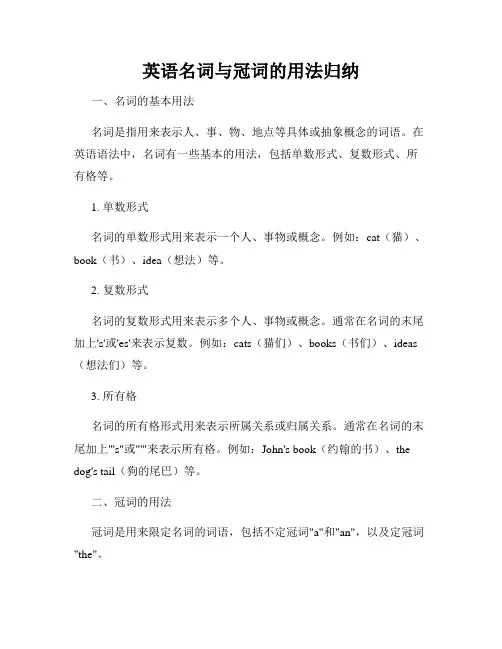
英语名词与冠词的用法归纳一、名词的基本用法名词是指用来表示人、事、物、地点等具体或抽象概念的词语。
在英语语法中,名词有一些基本的用法,包括单数形式、复数形式、所有格等。
1. 单数形式名词的单数形式用来表示一个人、事物或概念。
例如:cat(猫)、book(书)、idea(想法)等。
2. 复数形式名词的复数形式用来表示多个人、事物或概念。
通常在名词的末尾加上's'或'es'来表示复数。
例如:cats(猫们)、books(书们)、ideas (想法们)等。
3. 所有格名词的所有格形式用来表示所属关系或归属关系。
通常在名词的末尾加上"'s"或"'"来表示所有格。
例如:John's book(约翰的书)、the dog's tail(狗的尾巴)等。
二、冠词的用法冠词是用来限定名词的词语,包括不定冠词"a"和"an",以及定冠词"the"。
1. 不定冠词"a"和"an"不定冠词"a"和"an"用来表示泛指或不确定的人、事物或概念。
通常用"a"来修饰以辅音音素开头的单数名词,用"an"来修饰以元音音素开头的单数名词。
例如:a cat(一只猫)、an apple(一个苹果)等。
2. 定冠词"the"定冠词"the"用来表示特指或已知的人、事物或概念。
它可以修饰单数名词、复数名词以及不可数名词。
例如:the cat(那只猫)、the books(那些书)等。
三、名词与冠词的特殊用法除了基本的名词和冠词用法之外,还有一些特殊的用法需要注意。
1. 特指某个领域或行业的名词在某些特定的领域或行业中,名词前面会使用定冠词"the"来表示该领域或行业的特定事物。
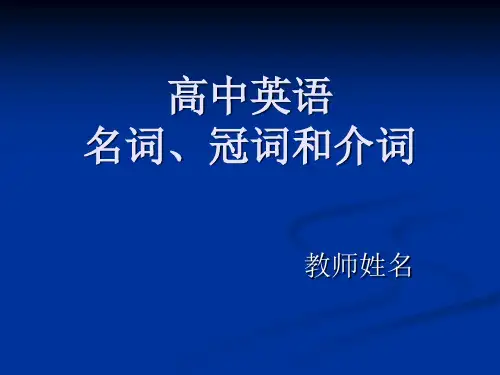
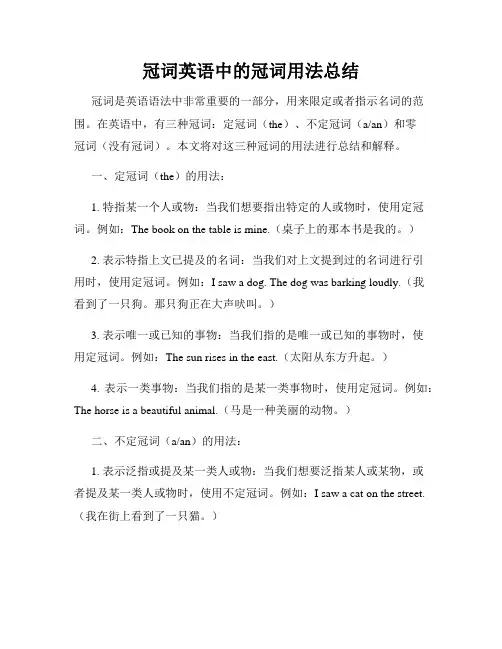
冠词英语中的冠词用法总结冠词是英语语法中非常重要的一部分,用来限定或者指示名词的范围。
在英语中,有三种冠词:定冠词(the)、不定冠词(a/an)和零冠词(没有冠词)。
本文将对这三种冠词的用法进行总结和解释。
一、定冠词(the)的用法:1. 特指某一个人或物:当我们想要指出特定的人或物时,使用定冠词。
例如:The book on the table is mine.(桌子上的那本书是我的。
)2. 表示特指上文已提及的名词:当我们对上文提到过的名词进行引用时,使用定冠词。
例如:I saw a dog. The dog was barking loudly.(我看到了一只狗。
那只狗正在大声吠叫。
)3. 表示唯一或已知的事物:当我们指的是唯一或已知的事物时,使用定冠词。
例如:The sun rises in the east.(太阳从东方升起。
)4. 表示一类事物:当我们指的是某一类事物时,使用定冠词。
例如:The horse is a beautiful animal.(马是一种美丽的动物。
)二、不定冠词(a/an)的用法:1. 表示泛指或提及某一类人或物:当我们想要泛指某人或某物,或者提及某一类人或物时,使用不定冠词。
例如:I saw a cat on the street.(我在街上看到了一只猫。
)2. 表示某一位(偶尔或新见面的)人:当我们指的是一个具体的人时,使用不定冠词。
例如:There is a woman waiting for you at the reception.(接待处有个女人在等你。
)3. 表示数量不确定的事物:当我们指的是数量不确定的事物时,使用不定冠词。
例如:He needs an hour to complete the task.(他需要一个小时来完成这个任务。
)三、零冠词的用法:1. 表示泛指事物:当我们泛指事物时,不使用任何冠词。
例如:I love reading books.(我喜欢阅读书籍。
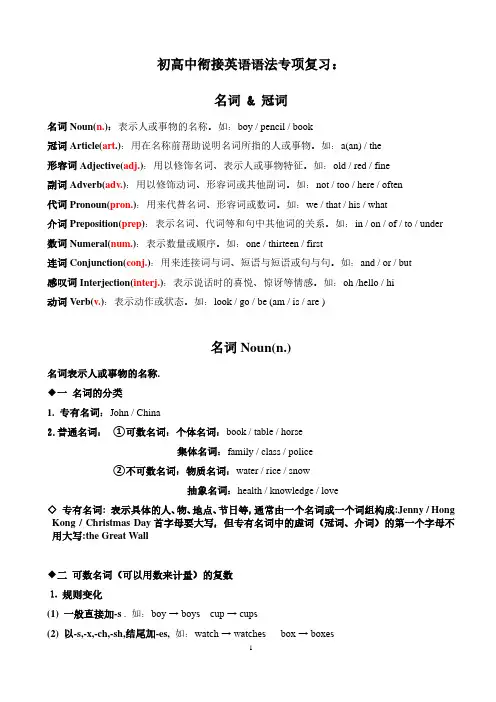
初高中衔接英语语法专项复习:名词 & 冠词名词Noun(n.):表示人或事物的名称。
如:boy / pencil / book冠词Article(art.):用在名称前帮助说明名词所指的人或事物。
如:a(an) / the形容词Adjective(adj.):用以修饰名词、表示人或事物特征。
如:old / red / fine副词Adverb(adv.):用以修饰动词、形容词或其他副词。
如:not / too / here / often代词Pronoun(pron.):用来代替名词、形容词或数词。
如:we / that / his / what介词Preposition(prep):表示名词、代词等和句中其他词的关系。
如:in / on / of / to / under数词Numeral(num.):表示数量或顺序。
如:one / thirteen / first连词Conjunction(conj.):用来连接词与词、短语与短语或句与句。
如:and / or / but感叹词Interjection(interj.):表示说话时的喜悦、惊讶等情感。
如:oh /hello / hi动词Verb(v.):表示动作或状态。
如:look / go / be (am / is / are )名词Noun(n.)名词表示人或事物的名称.◆一名词的分类1. 专有名词:John / China2.普通名词:①可数名词:个体名词:book / table / horse集体名词:family / class / police②不可数名词:物质名词:water / rice / snow抽象名词:health / knowledge / love◇专有名词: 表示具体的人、物、地点、节日等,通常由一个名词或一个词组构成:Jenny / Hong Kong / Christmas Day首字母要大写,但专有名词中的虚词(冠词、介词)的第一个字母不用大写:the Great Wall◆二可数名词(可以用数来计量)的复数⒈规则变化(1) 一般直接加-s . 如:boy → boys cup → cups(2) 以-s,-x,-ch,-sh,结尾加-es,如:wa tch → watches box → boxes注意:但是stomach(胃)的复数是stomachs;ox(公牛)的复数是oxen(3) 以“辅音字母+y ”结尾变y为i再加-es .如:story → stories baby → babies(4) 以f\fe结尾变f\fe为ves .如:①leaf → leaves;②self→ selves; ③wife → wives; ④knife → knives;⑤shelf→ shelves ⑥wolf→ wolves ⑦thief →thieves;⑧life →lives ⑨half → halves;①gulf→ gulfs ②roof→ roofs ③chief →chiefs ④serf→ serfs⑤belief→ beliefs ⑥proof →proofs ⑦handkerchief →handkerchiefs⑤以o 结尾:A.多加-es 如:Negro →Negroes hero → heroes; t omato—tomatoes potato—potatoes;mango—mangoes;volcano—volcanoes总结:英雄土豆爱番茄,黑人芒果看火山。
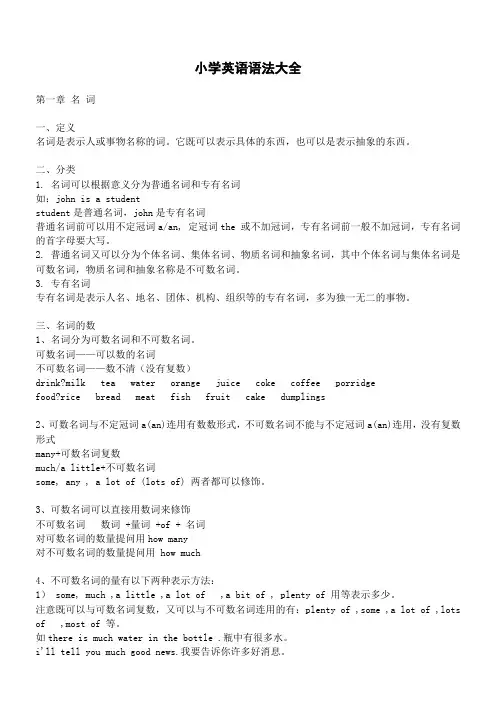
小学英语语法大全第一章名词一、定义名词是表示人或事物名称的词。
它既可以表示具体的东西,也可以是表示抽象的东西。
二、分类1. 名词可以根据意义分为普通名词和专有名词如:john is a studentstudent是普通名词,john是专有名词普通名词前可以用不定冠词a/an, 定冠词the 或不加冠词,专有名词前一般不加冠词,专有名词的首字母要大写。
2. 普通名词又可以分为个体名词、集体名词、物质名词和抽象名词,其中个体名词与集体名词是可数名词,物质名词和抽象名称是不可数名词。
3. 专有名词专有名词是表示人名、地名、团体、机构、组织等的专有名词,多为独一无二的事物。
三、名词的数1、名词分为可数名词和不可数名词。
可数名词——可以数的名词不可数名词——数不清(没有复数)drink?milk tea water orange juice coke coffee porridgefood?rice bread meat fish fruit cake dumplings2、可数名词与不定冠词a(an)连用有数数形式,不可数名词不能与不定冠词a(an)连用,没有复数形式many+可数名词复数much/a little+不可数名词some, any , a lot of (lots of) 两者都可以修饰。
3、可数名词可以直接用数词来修饰不可数名词数词 +量词 +of + 名词对可数名词的数量提问用how many对不可数名词的数量提问用 how much4、不可数名词的量有以下两种表示方法:1) some, much ,a little ,a lot of ,a bit of , plenty of 用等表示多少。
注意既可以与可数名词复数,又可以与不可数名词连用的有:plenty of ,some ,a lot of ,lots of ,most of 等。
如there is much water in the bottle .瓶中有很多水。
冠词的用法归纳详细讲解一、冠词的概念冠词是英语中一类重要的词性,用来修饰名词,并确定名词的特定程度或范围。
在英语中,主要有三种冠词:定冠词"the",不定冠词"a"和"an",以及零冠词。
二、定冠词1. 特指某人或某物(The)定冠词“the”用于特指已经提及过或特定的人或事物。
它常用于唯一存在的事物、国家和乐器等。
例句:- The sun rises every morning.太阳每天早上升起。
- The cat is sleeping in the garden.猫咪正在花园里睡觉。
- Have you ever been to the United States?你去过美国吗?2. 特指后面提到的名词(The)定冠词“the”也可用来表示特指后面将要提到的名词,尤其是当这个名词已经在文本中提到过时。
例句:- I saw a dog. The dog was barking loudly.我看到了一只狗。
那只狗正在大声吠叫。
3. 泛指整个类别(The)有时,“the”可以代表一个广义概念或抽象事物,表示整个类别。
例句:- The tiger is an endangered species.老虎是一种濒危动物。
- The Internet has changed the way we communicate.互联网改变了我们交流的方式。
三、不定冠词1. 泛指某个人或某件事(A / An)不定冠词“a”和“an”用于泛指一个人或一个事物,表示非特定或未提及过的事物。
例句:- I saw a cat on the roof.我在屋顶上看到一只猫。
- She wants to buy an apple.她想买一个苹果。
2. 不同音节开头的词使用规则(A / An)不定冠词“a”和“an”根据后面名词的发音来选择使用。
当该名词以辅音音素开头时,使用"a";当名词以元音音素开头时,使用'an'。
名词、代词和冠词的用法总结名词、代词和冠词是英语中非常重要的词类,它们在句子中起着不同的作用。
正确使用这些词类,能够使句子更加准确、清晰,并更好地表达自己的意思。
本文将对名词、代词和冠词的用法进行总结,并给出相关例句加以说明。
一、名词的用法1. 名词的基本功能名词是表示人、事物或抽象概念名称的词汇。
它可以作为主语、宾语、补语等在句子中充当不同的成分。
- 作为主语:- Dogs are loyal animals.(狗是忠实的动物。
)- Happiness is contagious.(幸福是具有感染力的。
)- 作为宾语:- She loves books.(她喜爱书籍。
)- I have a meeting tomorrow.(我明天有个会议。
)2. 可数名词与不可数名词可数名词表示可以计算或单独统计的事物,通常有复数形式;而不可数名词表示无法单独计算或统计的事物,没有复数形式。
- 可数名词:- There are three apples on the table.(桌子上有三个苹果。
)- I have two cats.(我有两只猫。
)- 不可数名词:- I need some water.(我需要一些水。
)- He has a lot of experience.(他有很多经验。
)3. 连用的名词有些名词可以连在一起形成一个整体,称为连用的名词。
- 作为复合名词:- The basketball game was exciting.(篮球比赛很精彩。
)- She has a part-time job.(她有一份兼职工作。
)- 作为领属关系的名词短语:- My mother's car is red.(我妈妈的车是红色的。
)- The president's speech was inspiring.(总统的演讲令人鼓舞。
)二、代词的用法1. 代词的基本功能代词用来代替名词,以减少对相同名称重复使用。
冠词-名词-代词冠词有两种,一是不定冠词a/an,另外一种是定冠词the一、不定冠词及其用法二、定冠词的用法1. 一般来说,普通名词有特指和泛指,如果特指,就要加定冠词;如果泛指,可数名词前加不定冠词,或用其复数形式2. 定冠词the主要和名词连用,表示某些特定的人或事物3. 由of引起的限定性短语(作定语)所修饰的词前加the4. 表示身体的某一部位,用the代替物主代词my, our, your, his, her等5. 表示江河海洋,海峡海湾,山脉和群岛及有些湖泊之前用the6. 定冠词the加姓氏的复数,表示某某一家人,如果做主语,谓语动词要用复数7. 当一个抽象名词,不表示一般的概念而是表示某一特定的内容时加定冠词the8. 由普通名词和一些其他词构成的专有名词前加the: the People's Republic of China三、同步练习1. ____rose is____beautiful flower.2. Mr. Smith always smokes____cigarette with ____cup of coffee.3.____door of____garage is broken.4.____donkeys are ____ stupid animals.5.____bread is made from ____ flour,and ____flour is made from ____wheat.6. She is ____good musician;she plays ____piano beautifully.7. Thousands of ____visitors go to ____Great Wall every ____day.8. When he was enghteen,he joined ____navy.9. He sent me ____letter and ____postcard;____letter didn't arrive.10. Li is not at ____office;I think he's gone____home.11. Is there ____telephone here?12. She is studying ____English and ____French.13. I bought ____pen and some paper,but I left____pen in ____shop.14. ____machine is made of ____steel and ____copper.15. ____honesty is ____best policy.16. ____coal is 60 dollars ____ton at the moment.17. I stay at ____home last night and listened to ____radio.18. We went to Paris and saw ____Palace of Versailles.19. He goes back to ____ country to see his people once ____year.20. ____Liu's are going to ____cinema.语法系列复习专题-----名词1. 名词的分类专有名词:指某人,某地,某机构等专有的名称,其首字母要大写。
名词前冠词用法冠词是一种虚词,是最典型的限定词,本身不能单独使用,只能附在一个名词上帮助说明名词的含义。
是名词的一种标志。
英语中的冠词有定冠词the和不定冠词a 、an两种:a用于辅音音素开头的词前,an用于元音音素开头的词前。
不定冠词仅用在可数名词单数前。
用来表示“—”的意思,但不强调数的观念,只说明名词为不特定者。
定冠词则表示名词为特定者。
表示“这,这些,那,那些”的意思,在可数名词单,复数前和不可数名词前都可以用。
1. 不定冠词的基本用法(1)不定冠词有a和an两种:a用于辅音音素开头的词前,an用于元音音素开头的词前。
例如:a boy, a city, a girl, a useful animal , an old man, an honest boy, a bad apple, a tall elephant(2)用来表示“—”的意思,但不强调数的观念,只说明名词为不特定者。
即不具体说明是何人何物。
例如:A teacher is looking for you.We work five days a week.(3)不定冠词含有“—”的意思,但数量观念没有one强烈,在句子里边一般可以不必译出,但若有“一个”的意思则译出,例如:—— An orange is good for you. 桔子对你有好处。
—— How much is it ? 多少钱?——Two yuan a kilo. 二元一公斤。
(4)一般用在可数名词单数前,指人或事物的某一种类。
例如:Bill is a student.Pass me an apple, please.例外:I have never seen such a fine film.(5)用在某些固定词组中。
例如:a lot of, a moment ago, a few, a little2. 定冠词的用法(1)特指某(些)人或某(些)事物。
例如:The book on the desk is mine.Show me the photo of the boy, please.(2)指双方都知道的人或事物。
冠词的用法总结
冠词(Articles)是英语特有的一种冠形词,他具有一定的修饰
能力。
总的来说,冠词的用法总结主要有5点:
1、冠词可以放在名词前,表示对名词所指的种类、个体或者概念
的限定,以区别于其他种类、个体或者概念。
如a dog 和the dog,
在a dog 中,a不限定dog,而the dog 表示“某只/那只dog”,即
特指某种dog。
2、如果名词前没有冠词,那么就以数量意义上的复数来表达名词
的复数概念,以此来区分名词的单数和复数概念。
例如:dogs (复数)和dog(单数)。
3、冠词可以放在抽象名词、短语、固定搭配及介词短语前,表示
抽象概念时,没有冠词;表示特殊概念,可以加the;表示不指特定概念,可以加a 或者an。
例如:He likes music(抽象),He likes
the music in the cafe(特殊),He likes a music club(不特定)。
4、冠词可以放在表示时间、距离等的副词前,用来强调特定的意思。
例如:He goes once a week,He goes the Saturday,He goes
a long way。
5、有些常见的表示事物的固定搭配一般使用冠词,如 make a start, take part in, catch sight of, have a look at, get a
hold of, give a hand to等。
以上是冠词的用法总结,一般来说,冠词的作用是表达特指与不
特指的意思,它可以使语句变得具体和准确,以便表达各种场景。
英语语法知识:名词、代词和冠词1. 名词:表示人或事物的名称的词叫名词。
名词在句子中可以作主语,宾语,表语,宾语补足语,定语,名数词连用可以做状语。
在使用名词时,要注意区分可数名词和不可数名词,以便于正确使用表示不确定数量的定语。
如:a lot of / plenty of / some 可以修饰可数名词和不可数名词。
而:many, a few, few several, scores of, large quantities of, dozens of, a couple of 等只能用在可数名词之前,much, a great deal of, a little, little, a great amount of 等只能用在不可数名词之前。
2. 冠词:冠词是一种虚词,放在名词前面,帮助说明名词的意义。
冠词有不定冠词和定冠词两种。
a (an)是不定冠词,an用在元音发音开始的词语前。
如:an hour, an English book。
the 是定冠词。
1)不定冠词:不定冠词a (an)只能用在单数可数名词前。
关于它的用法,用四个字概括,“每、一、类、某”。
①表示“每日”、“每周”……Please take this medicine three times a day.②表示某一种人或物中的一个。
All of us know that he is a teacher, not a student.③表示某一类人或物。
It is an easy task for an elephant.④表示“某一个”,但仍译为“一个”、“有个”。
One day, a Frenchman went to Berlin on business.2)定冠词的用法:①特指某人或某物,指说话人与听话人都知道的人或物。
Look at the picture. Is there a man in the picture?②复指前面已提到的人或物。
( ) 1 She was very happy. She in the maths test.A. makes a few mistakeB. made a few mistakesC. made few mistakesD. makes few mistake( ) 2 We need some more____. Can you go and get some, please?A. potatoB. potatosC. potatoesD. potatoe( ) 3 _____are____for cutting things.A. Knife/usedB. Knives/usedC. Knife/usingD. Knives/using( ) 4 What big____ the tiger has!A. toothB. teethC. toothsD. toothes( ) 5 Please remember to give the horse some tree___.A. leafsB. leavesC. leafD. leave( ) 6 -Can we have some ___?-Yes, please.A. bananaB. orangesC.appleD. pear( ) 7 On the table there are five____.A. tomatosB. piece of tomatoesC. tomatoesD. tomato2( ) 1 They got much ___ from those new books.A. ideasB. photosC. informationD. stories( ) 2 He gave us____ on how to keep fit.A. some advicesB. some adviceC. an adviceD. a advice( ) 3 When we saw his face, we knew___ was bad.A. some newsB. a newsC. the news P. news( ) 4 What___ lovely weather it is!A. /B. theC. anD. a3( ) 1 -Would you like___tea?-No, thanks. I have drunk two____.A. any, bottles of orangeB. some, bottles of orangeC. many, bottles of orangesD. few, bottle of oranges( ) 2 He is hungry. Give him ___ to eat.A. two breadsB. two piece of breadC. two pieces of breadD. two pieces of breads( ) 3 It really took him:___ to draw the nice horse.A. sometimesB. hourC. long timeD. some time( ) 4 I would like to have___.A. two glasses of milkB. two glass of milk IC. two glasses of milksD. two glass of milks( ) 5 Can you give me ____?A. a teaB. some cup of teaC. a cup teaD. a cup of tea( ) 6 Please give me ___ paper. A. one B. a piece C. a D. a piece of( ) 7 John bought___for himself yesterday.A. two pairs of shoesB. two pair of shoeC. two pair of shoesD. two pairs shoes( ) 1 -How many ____ have you got on your farm?-I've got five.A. sheepsB. sheepC. pigD. chicken( ) 2 Some ___ came to our school for a visit that day.A. GermansB. GermenC. GermanyD. Germanies( ) 3 In the picture there are many____ and two.A. sheep; foxes C. sheeps; foxesB. sheeps; fox D. sheep;foxs( ) 4 A group of______ will visit the museum tomorrow.A. HungarianB. AustralianC. JapaneseD. American5( ) 1 This table is made of___.A. many glassB. glassesC. some glassesD. glass( ) 2 -What would you like to have for lunch, sir?-I'd like____. !A. chickenB. a chickenC. chickensD. the chicken( ) 3 Children should make____ for old people in a bus.A. roomB. a roomC. roomsD. the room6( ) 1 Tables are made of___.A. woodB. some woodsC. woodenD. woods( ) 2 I wonder why ______ are so interested in action (武打片) films.A. peopleB. peoplesC. the peopleD. the peoples( ) 3I have read____ of the young writer.A. worksB. workC. this worksD. the works7( ) 1 Let's meet at 7: 30 outside the gate of___?A. the People's ParkB. the Peoples' ParkC. the People ParkD. People's Park( ) 2 ___ Chinese people are ___ hard working people.A. /; aB. We; theC. The; theD. The; a( ) 3 How many were there in the street when the accident happened?A. policemanB. policesC. policeD. peoples8( ) 1 If these trousers are too big, buy a smaller____.A. setB. oneC. pieceD. pair( ) 2 Last week I bought a TV____.A. pair .B. setC. pieceD. block( ) 3 There is a of wood left on the ground.A. cupB. piece ,C. boxD. pair9( ) 1 There are sixty-seven___ in our school.A. women's teacherB. women teachersC. woman teachersD. women teacher( ) 2 There are five___in our factory.A. woman driver B, women driver C. woman drivers D. women drivers ( ) 3 These ____ were sent to the villages to help the farmers.A. women doctorB. women doctorsC. woman doctorsD. woman doctor10( ) 1 They write most of their___ in English.A. business letterB. business lettersC. businessesD. businesses letters ( ) 2 We came to a ___ at last .and went in.A. watch shopB. watches shop ,'C. watching shopD. watchs shop( ) 3 This shop sells apples, bananas and things like these. It's a___.A. food shopB. book shopC. fruit shopD. vegetable shop( ) 4 She broke a___while she was washing up.A. glass of wineB. glass for wineC. glass wineD. wine glass( ) 5 I've forgotten both of the____.A. room numbers .B. rooms numberC. rooms numbersD. room number111. September 10th is____in China.A. Teacher's DayB. Teachers'DayC. Teacher DayD. Teachers Day( ) 2 -Is the broom under ____ desk? -No, it's under____.A. the teacher's; myB. teacher's; mineC. teacher's; meD. the teacher's; mine ( ) 3 Excuse me, where is the___?A. men's roomB. mens' roomC. men's roomsD. men rooms12( ) 1 The football under the bed is____.A. Lily and LucyB. Lily's and Lucy'sC. Lily's and LucyD. Lily and Lucy's( ) 2 This is my____dictionary.A. sister MaryB. sister'sC. sister, Mary'sD. sister's Mary's( ) 3 He went to ___ shop to buy a shirt.A. a tailorB. the tailorC. a tailorsD. the tailors'( ) 4 Joan is____.A. Mary's and Jack sisterB. Mary and Jack's sisterC. Mary and Jack sisterD. Mary's and Jack's sister13( ) 1 In a few____ time, those mountains will be covered with trees.A. yearB. years'C. year'sD. years( ) 2 It's about ___ walk from my house.A. ten minuteB. ten minutes'C. ten minute'sD. ten minutes( ) 3 The post office is a bit far from here. It's about_____.A. thirty minutes's walkB. thirty minute's walkC. thirty minutes' walkD. thirty minutes walk( ) 4 Half___ telephone calls are made in English.A. the worldB. worldC. the world'sD. world's14( ) 1 ____ face to the south.A. Windows of the roomB. The windows of the roomC. The room's windowsD. The windows in room( ) 2 Please take two___.A. picture of the parkB. pictures of the parkC. the pictures of a parkD. picture of a park( ) 3 The workers are repairing____.A. the roof of the houseB. a roof of the houseC. roof of the houseD. this roof of house15( ) 1 Miss Smith is a friend of____.A. Mary's mother'sB. Mary's motherC. mother's of MaryD. Mary mothers ( ) 2 This is a book of ___.A. TomB. Tom'sC. herD. him( ) 3 The post card is sent by ____.A. a friend of my fatherB. a friend of my father'sC. my father friendD. my father friend's16( ) 1 Sydney is a city of___.A. AmericaB. GermanyC. AustraliaD. Japan( ) 2 My father likes buying us ___.A. carsB. flowersC. peasantsD. presents( ) 3 In England, the last name is the ___.A. full nameB. family nameC. middle nameD. given name( ) 4 Mr Gao is a teacher. He works in a new____.A. shopB. schoolC. factoryD. hospital17( ) 1 My father is a____. He works in a hospital.A. teacherB. doctorC. farmerD. soldier( ) 2 -Which animal lives only in China?-The____.A. tigerB. monkeyC. pandaD. elephant( ) 3 April come before___and after___.A. March; MayB. May; MarchC. June; MayD. March; February( ) 4 Which of the following is right?A. China has a large population.B. China has much population.C. China has many populations.D. China has a great deal of population. ( ) 5 Please do like this. Fold the paper____ and cut along the fold.A. into piecesB. in halfC. on halvesD. to half( ) 6 You played the violin wonderfully. Will you please play another____?A. oneB. gameC. programmeD. piece参考答案:1. 1-7 C C B B B B C2. 1-4 C B C A3. 1-7 B C D A D D A4. 1-4 B A A C5. 1-3 D A A6. 1-3 A A D7. 1-3 A D C8. 1-3 D B B9. 1-3 B D B10. 1-5 B A C D A11. 1-3 B D A12. 1-4 D C C B13. 1-4 B B C C14. 1-3 B B A15. 1-3 A B B16. 1-4 C D B B17. 1-6 B C B A B Dothers3. Our manager allowed _______to take a holiday next week.A. you and IB. yourself and meC.I and youD. you and me4. Although he 's wealthy,he spends___ on clothes. A. little B. few C. a little D. a few5. They were all tired, but _____ of them would stop to take a rest.A. anyB. someC. noneD. neither6. I don’t know whether small oranges are sweeter than big ______.A. thoseB. onesC. oneD. that 7. When they met, they stopped and said hello to_______ .A. each otherB. each anotherC. the other each D .each one8. After everyone took_______ place, the meeting began.A. hisB. theirC. thereD. the9. -Why don’t we take a little break? -Didn’t we just have _______?A. itB. thatC. oneD. this10. If you want to change for a double room you’ll have to pay ___$15.A. anotherB. otherC. moreD. each 11. We should always keep ______ well-informed of the changing information.A. usB. oursC. ourselvesD. we 12. Give the message to ______ is at the table.A. whomeverB. whoseverC. whateverD. whoever13. I found _______impossible for _______to work out the maths problem.A. it; himB. it; heC. that; himD. that; he14. Few pleasures can equal _____ of a cool drink on a hot day.A. someB. anyC. thatD. those15. I hate ______ when people talk with their mouths full.A. itB. thatC. theseD. them 16. Mary learned Chinese for about two years, _______is, fro m 1993 to 1995.A. thisB. thatC. itD. he17. She is doing her homework.I'll do_______.A. suchB. soC. the sameD. the same as18. In some restaurants, food and service are worse than ______ used to be.A. theyB. itC. themD. that19. Everyone who comes to the party is given a wooden apple with _____ own names cut in it asa souvenir.A. hisB. herC. theirD. our20. Children can usually dress ______ by the age of five.A. himB. themC. himselfD. themselves【练习答案】一。